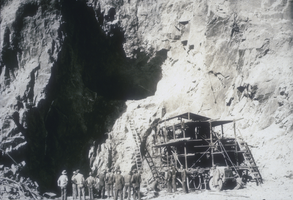Search the Special Collections and Archives Portal
Search Results

Meeting minutes for Consolidated Student Senate University of Nevada, Las Vegas, October 4, 1984
Date
Archival Collection
Description
Text
UNLV University Libraries Collection of Architecture Drawings
Identifier
Abstract
UNLV University Libraries Collection of Architecture Drawings contains original hand-drawn architectural drawings, print reproductions, computer generated prints, and board-mounted artist renderings dating between 1926 and 2003. The collection primarily focuses on Las Vegas, Nevada, but also includes projects throughout Nevada and other states including Utah, Arizona, California, Mississippi, and Colorado.
Archival Collection
Lucela M. Wattin oral history interview
Identifier
Abstract
Oral history interview with Lucela M. Wattin conducted by Stefani Evans on December 6, 2021 for Reflections: The Las Vegas Asian American and Pacific Islander Oral History Project.
Lucela shares memories of her life growing up in Cebu Province, Philippines and being raised by her mother and grandparents after her father's death. She talks about immigrating to the United States under her fiancée's visa, moving to Chinatown in Las Vegas, and her work as a busser at the Excalibur Hotel. Lucela discusses how joining the Culinary Workers Union improved her work conditions and benefits, and how she is working with the union and a legal attorney to help her daughter immigrate to America. She also shares her favorite Filipino dishes (sinagang, chicken adobo, and bugas mais), holiday traditions, and what life was like when casinos shut down during COVID-19.
Archival Collection

Letter from Calvin M. Cory (Las Vegas) to Edward C. Renwick, December 20, 1952
Date
Archival Collection
Description
Cory expresses the legal opinion that in an artesian basin, if you have a water right then the point of diversion makes no difference.
Text

Epilogue: UNLV Yearbook, 1972
Date
Description
Yearbook main highlights: schools and departments; detailed lists with names and headshots of faculty, administration and students; variety of photos from activities, festivals, campus life, and buildings; campus organizations such as sororities, fraternities and councils; beauty contest winners; college sports and featured athletes; and printed advertisements of local businesses; Institution name: University of Nevada, Las Vegas
Mixed Content
Frey, James H. (1941 June 29-)
James Frey was born in Eureka, South Dakota, in 1941. His father worked in creamery and his mother was a registered nurse. When Frey was nine, the family, including his twin sister, relocated in Sioux Falls where his dad was plant manager for a dairy. He joined the YMCA in the fourth grade and ended up working for them until around the age of 22. He attended Augustana College in Sioux Falls, graduating with a major in sociology and a minor in history. After graduation, he worked for three years at the YMCA in Sioux Falls as program director.
Person
Corporate records, 1920 to 1992, 1927 to 1979
Level of Description
Scope and Contents
The corporate records (1920-1990) for Hughes Productions consist of administrative, distribution, financial, and legal records, as well as records from the Motion Picture Association of America and United Artists Corporation and records pertaining to unproduced works.
Administrative records contain correspondence, as well as vault inventories, assets list, and personnel files. Distribution records contain agreements, correspondence, and information pertaining to The Outlaw's ban. Financial records include ledgers, correspondence, invoices, and international profit reports. Legal records include contracts for actors and screenwriters, as well as correspondence, agreements, and affidavits pertaining to loan information and court case proceedings.
Motion Picture Association of America (MPAA) records consist primarily of weekly reports from the MPAA detailing film title registration reports either held or withdrawn, as well as memoranda. United Artists Corporation records include contract analyses, settlement statements and ledgers detailing The Outlaw's domestic and international earnings. Unproduced works contain screenplays, synopses, story treatments, right's agreements, and correspondence pertaining to stories sent to Hughes Productions.
Archival Collection
Collection Name: Howard Hughes Film Production Records
Box/Folder: N/A
Archival Component

Photograph of pickers at work harvesting celery plants on the Iki Ranch near Logandale, Nevada, June 4, 1947
Date
Archival Collection
Description
Men harvesting celery on the Iki ranch near Logandale, Nevada.
Transcribed Notes: Bureau of Reclamation typed notes appended to back of photo: Boulder Canyon Project, Nevada Region 3 "Pickers" at work harvesting celery plants on the IKI Ranch near Logandale, Nevada. Raising celery plants is a relatively new type of irrigated specialty farming in southern Nevada. Water from the Muddy River is used to irrigate the fields. Twenty million celery plants were harvested from the 60 acres planted this season. The plants were shipped to the neighboring western states.
Image

Slide of the construction phase of Hoover Dam, November 18, 1931
Date
Archival Collection
Description
Image
